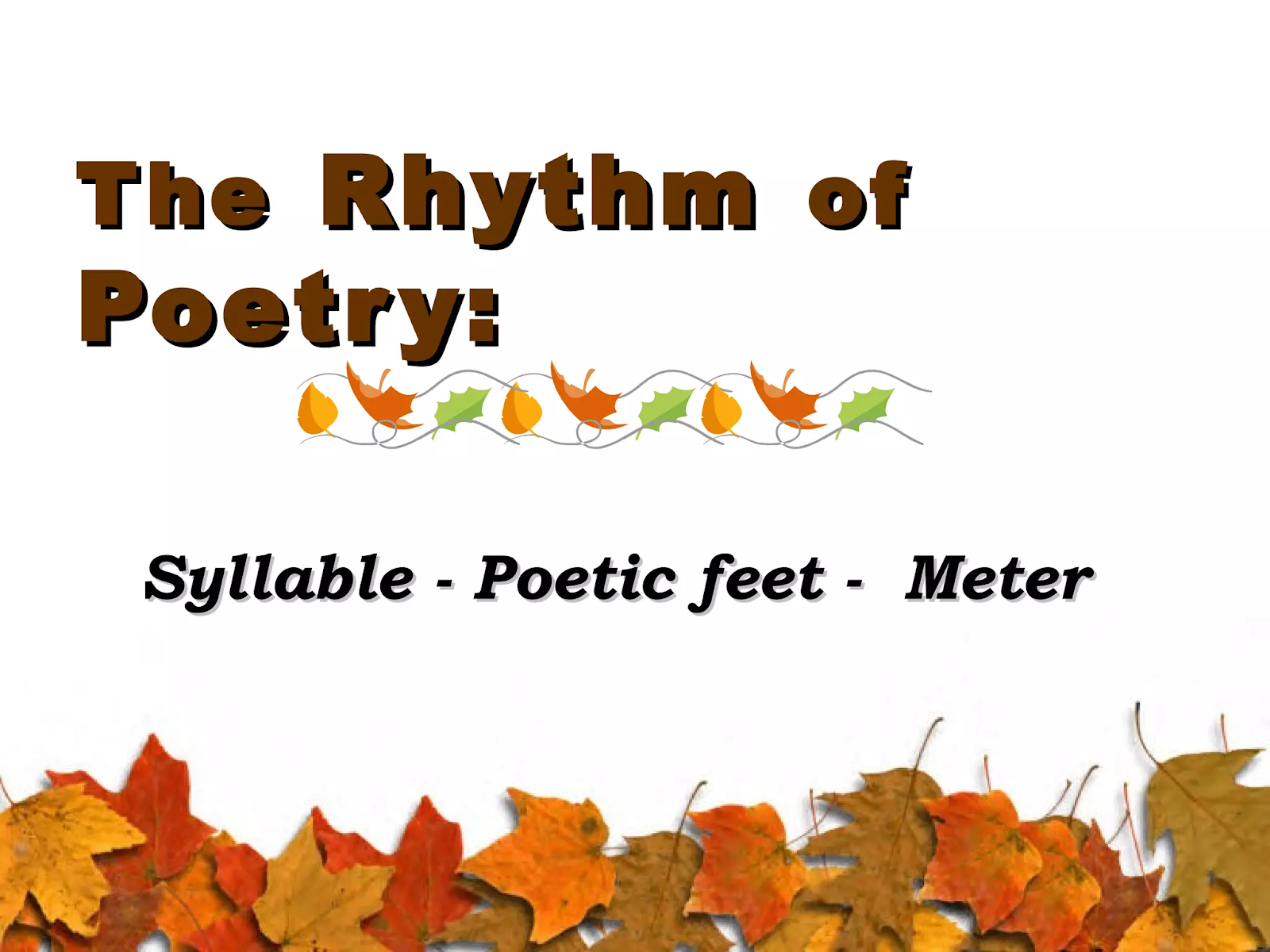What is Prosody?
Prosody is a technical term used in linguistics and poetry to describe the patterns, rhythms or meters of a language.
Prosody can refer to the rules for the pronunciation of a language as well as its versification. The correct pronunciation of words includes:
- Enunciation,
- Proper accenting
- Making sure each syllable has its required length
Metre or Meter
Term meter is "the systematic arrangement of words involving stressed and unstressed syllables." Meter describes a form of poetic measure related to the length and rhythm of a line in poetry. The study of meter is known as prosody.
The word is derived from the Old French Metre, which referenced the specific use of “metrical scheme in verse.” However, it originated from the Latin word Metrum, from the Greek Metron, meaning “meter, a verse; that by which anything is measured; measure, length, size, limit, proportion.” The use of the literary term meter is dated to the 14th century, where it connotes “versification.”
Difference between Meter and Rhythm
These are similar but not identical concepts. Rhythm refers to the overall tempo, or pace, at which the poem unfolds, while meter refers to the measured beat established by patterns of stressed and unstressed syllables. Poets who write free verse, generally de-emphasize or ignore meter and focus instead on refining and tuning their natural speech rhythms to suit the poem's tone and content.
Why use Meter?
It creates a rhythm and often gives a formality that elevates the language of a poem.
The pattern of stressed and unstressed meter creates a lovely, lyrical tone and helps to heighten the reader's enjoyment and experience of the poem, especially when used along with rhyme and other poetic devices.
At the beginning of its usage poem with a consistent meter was called accentual-syllabic verse.
Meter is determined by the number and pattern of its stressed and unstressed syllables known as a Foot. These syllables are organized into what is called feet.
Metrical feet are repeated sequences of meter composed of two or more accented or unaccented syllables. An accented syllable also is called a beat.
Scansion/Scanning/Scan: The task of determining the meter of a line, of being able to find the proper name of a poetic line, is called scanning or scansion.
Types of Meters
Foot – A foot is a pair of stressed and unstressed syllables.
Historical Origin
The term "iamb" was devised in classical Greek prosody as “iambos,” referring to a short syllable followed by a long syllable. The Latin word is "iambus." Greek poetry was measured in quantitative meter, determined by the length of the word sounds, while English poetry, from the time of Chaucer through the 19th century, has been dominated by accentual-syllabic verse, which is measured by the stress or accent given to syllables when a line is spoken. A style of poetry known as blank verse also uses iambic pentameter, yet in this case, rhyming is not required or encouraged.
An iambic foot consists of two syllables, the first unstressed and the second stressed so that it sounds like “da-DUM.” One iambic foot can be a single word or a combination of two words:
- "away" is one foot: "a" is unstressed, and "way" is stressed
- "the crow" is one foot: "the" is unstressed, and "crow" is stressed
A perfect example of iambs is found in the last two lines from Shakespeare’s Sonnet 18:
So LONG / as MEN / can BREATHE / or EYES / can SEE,
So LONG / lives THIS,/ and THIS / gives LIFE / to THEE.
Trochee (Trochaic) Stressed + Unstressed
A trochee is a two-syllable metrical pattern in poetry in which a stressed syllable is followed by an unstressed syllable. The word "poet" is a trochee, with the stressed syllable of "po" followed by the unstressed syllable, “et”: Po-et. The opposite of a trochee is an iamb.
Shakespeare used a trochaic meter to give an eerie and ominous feeling to the spells he wrote for the witches in Macbeth.
Double, double toil and trouble;
Fire burn, and caldron bubble.
Scale of dragon; tooth of wolf;
Witches' mummy; maw and gulf...
Spondee (Spondaic) Stressed + Stressed
A spondee is a two-syllable metrical pattern in poetry in which both syllables are stressed. The word "downtown" is a spondee, with the stressed syllable of "down" followed by another stressed syllable, “town”: Down-town.
Pyrrhic
The term “pyrrhic” is used to refer to a metrical foot that contains two unstressed syllables. Forexamle “To a green thought in a green shade.”
Anapest (Anapestic) Unstressed + Unstressed + Stressed
An anapest is a three-syllable metrical pattern in poetry in which two unstressed syllables are followed by a stressed syllable. The word "understand" is an anapest, with the unstressed syllables of "un" and "der" followed by the stressed syllable, “stand”: Un-der-stand.
Dactyl (Dactylic) Stressed + Unstressed + Unstressed
The opposite of an anapest is a dactyl, a metrical foot consisting of a stressed syllable followed by two unstressed syllables (as in the word "Po-e-try").
The Greek root is daktylos, which means "unit of measure" but also "finger." The literary term came from the "finger" meaning — the three bones in a finger represent the three syllables in a dactyl.
The first stanza of Tennyson’s famous poem "The Charge of the Light Brigade"—you can clearly see the stressed-unstressed-unstressed metrical pattern throughout.
Half a league, half a league,
Half a league onward,
All in the valley of Death
Rode the six hundred.
"Forward, the Light Brigade!
Charge for the guns!" he said.
Catalexis – the absence of a syllable at the beginning or end of a line of metrical verse resulting in an incomplete foot, most often occurring in the last foot at the end of a verse; a catalectic line.
Special Names The followings are names of meter & line length
Monometer-One foot
Dimeter-Two feet
Trimeter-Three feet
Tetrameter-Four feet
Pentameter-Five feet
Hexameter-Six feet
Heptameter-Seven feet
Octameter-Eight feet
















